Considering the avalanche of tablets now on the market one could be forgiven for thinking “How will this one be any different?” The HTC Flyer, though, is nothing if not unique.Yes, it's an Android tablet; but one which has decided to zig when every other droid tablet out there has zagged. It doesn't feature the stock Honeycomb for tablets and goes with Gingerbread instead. It’s topped with the HTC Sense UI 2.1 for tablets which looks equally good upscaled to the bigger 7” screen, and has the brand new lockscreen from Sense 3.0.There’s a 1.5 GHz single-core processor instead of a dual-core Tegra-or-something chip. The Flyer boasts HTC’s Scribe technology giving you drawing powers on any screen on the tablet. The aluminum unibody has the trademark HTC feel all over it. Oh yes… It's a cool gadget by any standards.



HTC Flyer official shots
Facing very tough competition, the Flyer relies on its user experience and innovative drawing/imaging
technology to up the scales and get on your wish list. While it certainly can't compete with dual-core-powered slates in terms of FullHD 1080p video or the latest games with Unreal 3D engine and whatnot, it can still give users a rich, fun experience. The fact is it’s really pocketable and no burden to handle for longer than 10 minutes. You can literally take it anywhere without having to carry a special bag for it.
And here’s what the Flyer will bring along.
Key features
- 7.0" 16M-color LCD capacitive touchscreen of WSVGA (600 x 1024 pixels) resolution
- Single-core ARMv71500MHz CPU, 1GB RAM, 16/32GB of user-available storage
- Android 2.3.3 (Gingerbread) with HTC Sense 2.1 UI
- Quad-band GSM 850/900/1800/1900 and tri-band 3G 900/1700/2100 support
- 14.4 Mbps HSDPA, 5.76 Mbps HSUPA
- Wi-Fi 802.11 b/g/n with hotspot functionality
- GPS with A-GPS support; digital compass
- 5 MP 2592x1944 pixels resolution autofocus camera
- 1.3 MP front-facing camera
- 720p HD video recording @30fps
- microUSB port and stereo Bluetooth v3.0
- microSD slot (up to 32GB)
- Flash 10.1 support
- DivX/Xvid support
- Standard 3.5 mm audio jack
- Accelerometer and proximity sensor
- Document viewing and editing out of the box
- HTC Scribe technology with Magic pen (separate purchase for the Wi-Fi only model)
- Aluminum unibody design
- Two sets of touch-sensitive controls for landscape and portrait use
- 4000 mAh Li-Ion rechargeable battery
Main disadvantages
- Weighs almost as much as an 8.9" tablet
- Charges only with the supplied HTC charger
- Non-replaceable battery
- Lower resolution than current crop of droid slates
- Lack of dual-core processor
- Android 2.3.3 Gingerbread instead of 3.0 Honeycomb
- 5 MP camera has obvious lens issues
- No telephony
Choosing Android 2.3.3 Gingerbread instead of Honeycomb gives the Flyer the advantage of using a custom user interface and full support for the majority of apps out there. (Some regular Android apps have compatibility issues with Honeycomb slates).The downside is absolutely no support for Honeycomb apps, which are the ones meant for tablet use to begin with.
With the Flyer, you choose between a 3G-enabled and Wi-Fi-only version. Either way, phone calls are not available.
So much for raw specs and expectations. What we're here for is the actual performance. We’re back after the break and eager to see how the Flyer handles pressure.



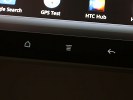
Design and construction
HTC has almost patented the stylish aluminum unibody construction , which is stunning - especially on a bigger handset like the Flyer (yes it's actually compact enough to be called that) - so this tablet is definitely a looker.It feels great in your hand and both the finish and body materials are top notch. It's comfortable to hold and feels sturdy.

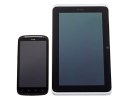
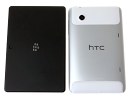
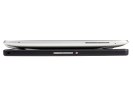
HTC Flyer side by side with the HTC Sensation and the BlackBerry Playbook
We do like aluminum casings. Plastic is okay but just can't beat the premium feel of cold metal.
The body of the Flyer is curved at every corner and has slightly pronounced top and bottom edges to protect the screen when you place it on its face. The back is curved and mostly made of aluminum.
The 7" 16M-color capacitive screen offers good brightness indoors but is too reflective to comfortably use in the open. Even on the highest settings it feels shy in direct sunlight and will make you wish for a parasol or something.
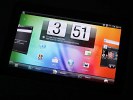
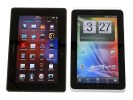
HTC Flyer LCD display
Other than that, when indoors, colors are punchy and contrast is good, so the Flyer does have a good display overall.
| Display test | 50% brightness | 100% brightness | ||||
| Black, cd/m2 | White, cd/m2 | Black, cd/m2 | White, cd/m2 | |||
| HTC Flyer | 0.18 | 169 | 921 | 0.41 | 409 | 1002 |
| Motorola XOOM | 0.12 | 216 | 1853 | 0.21 | 436 | 2041 |
| Apple iPad 2 | 0.18 | 167 | 925 | 0.55 | 429 | 775 |
| Apple iPad | 0.21 | 178 | 834 | 0.53 | 410 | 776 |
| HTC Incredible S | 0.18 | 162 | 908 | 0.31 | 275 | 880 |
| HTC Sensation | 0.21 | 173 | 809 | 0.61 | 438 | 720 |
Above the display in landscape mode are the secondary video-call camera and a status LED, which lights up when you turn the camera on. It is a 1.3 MP unit, good enough for Skype video calls and the likes.

Secondary camera, light sensor
There are a total of 8 capacitive buttons on the Flyer. HTC has conveniently decided to put them in two sets for use in both landscape and portrait mode. They are the Home, Menu and Search keys along with a dedicated Scribe button. When Scribe mode is active, a touch with the stylus to the Scribe capacitive button will open up the settings menu. More on that later.


Capacitive buttons
The right side of the tablet features the volume rocker and two sets of microphones. They are positioned at the top and bottom of the side. They are probably meant for stereo sound recording during video capture.
The volume rocker has nice press and is large enough for comfortable use.

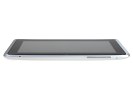
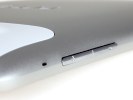
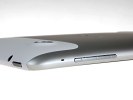
| source |




0 comments:
Post a Comment